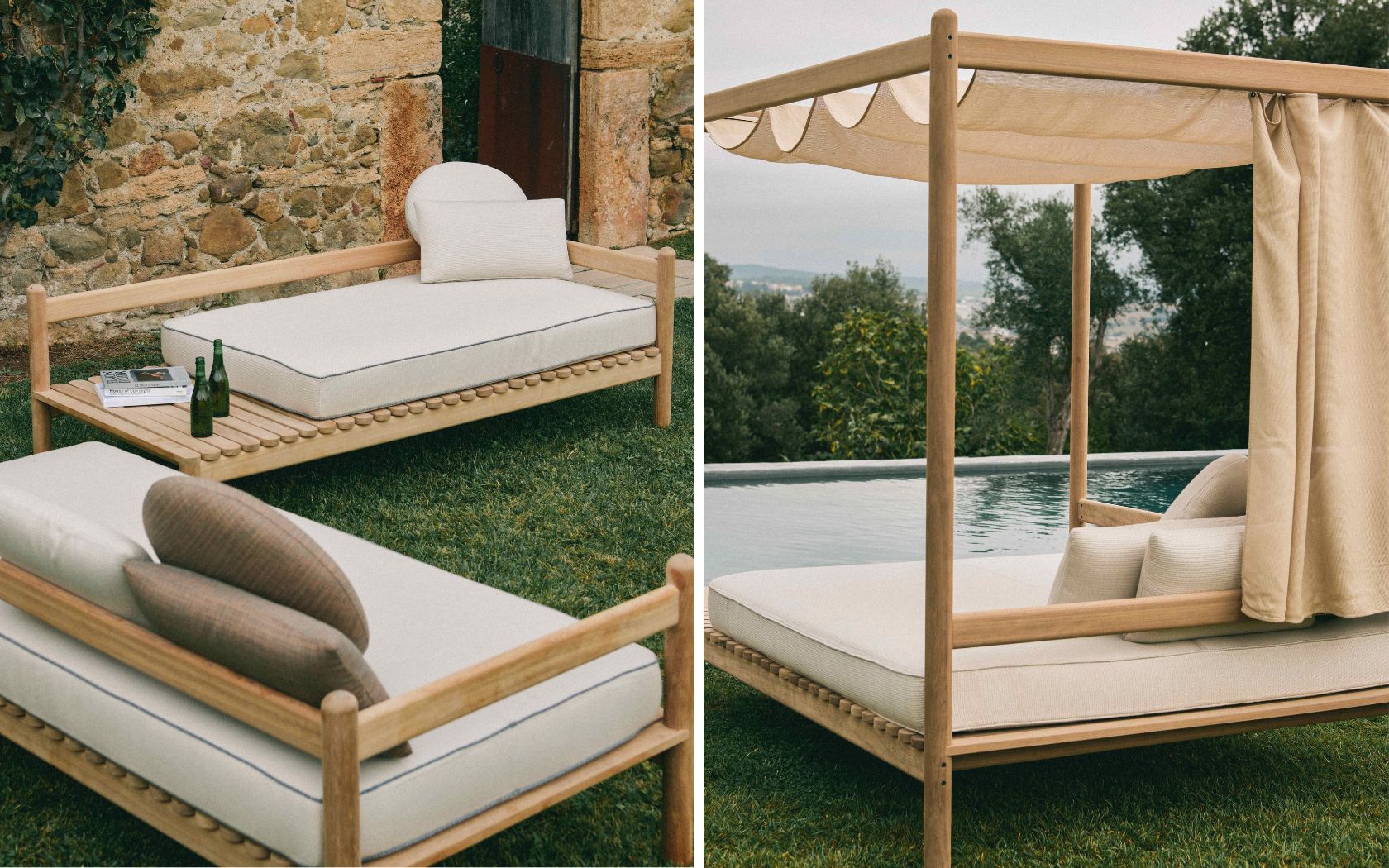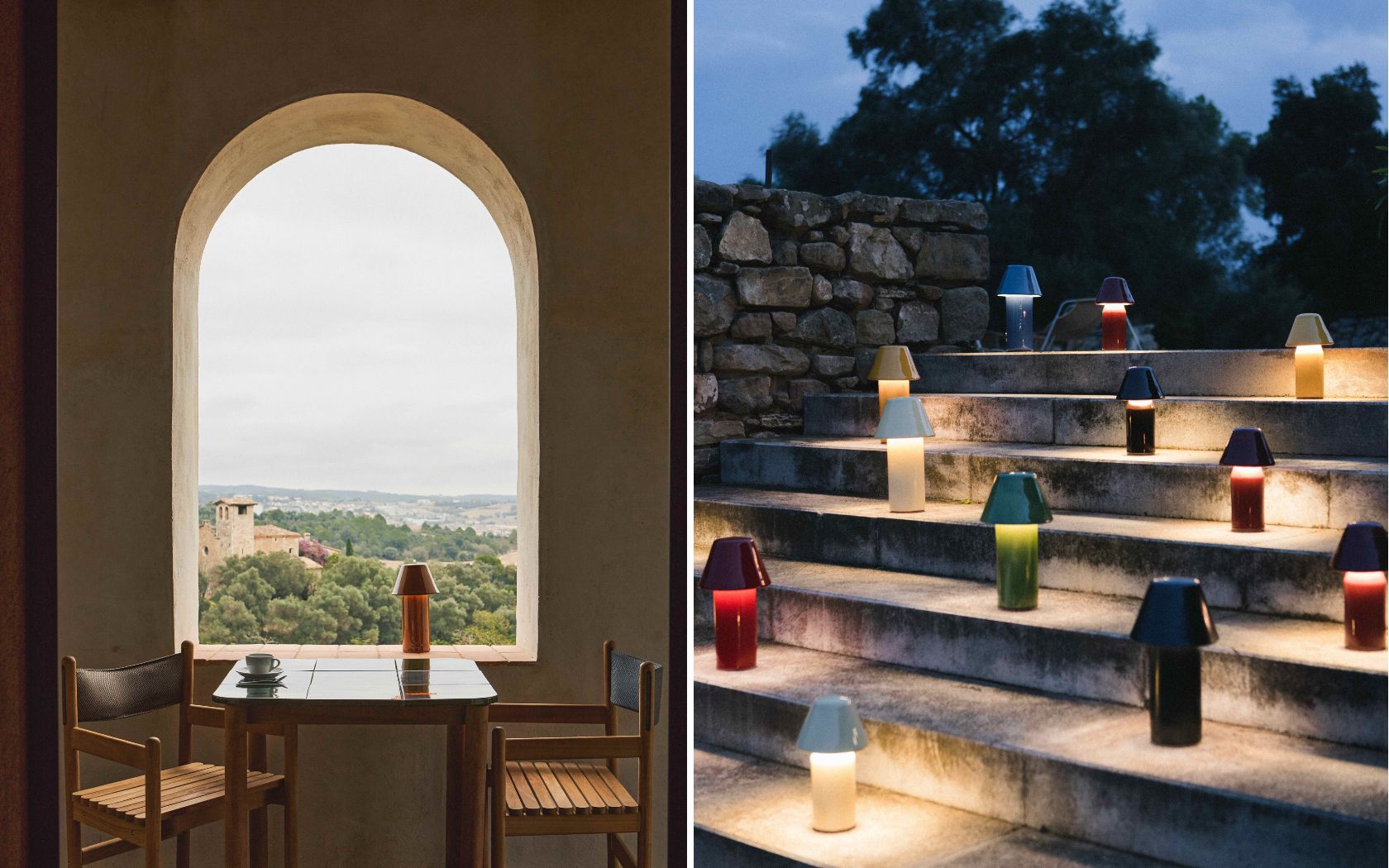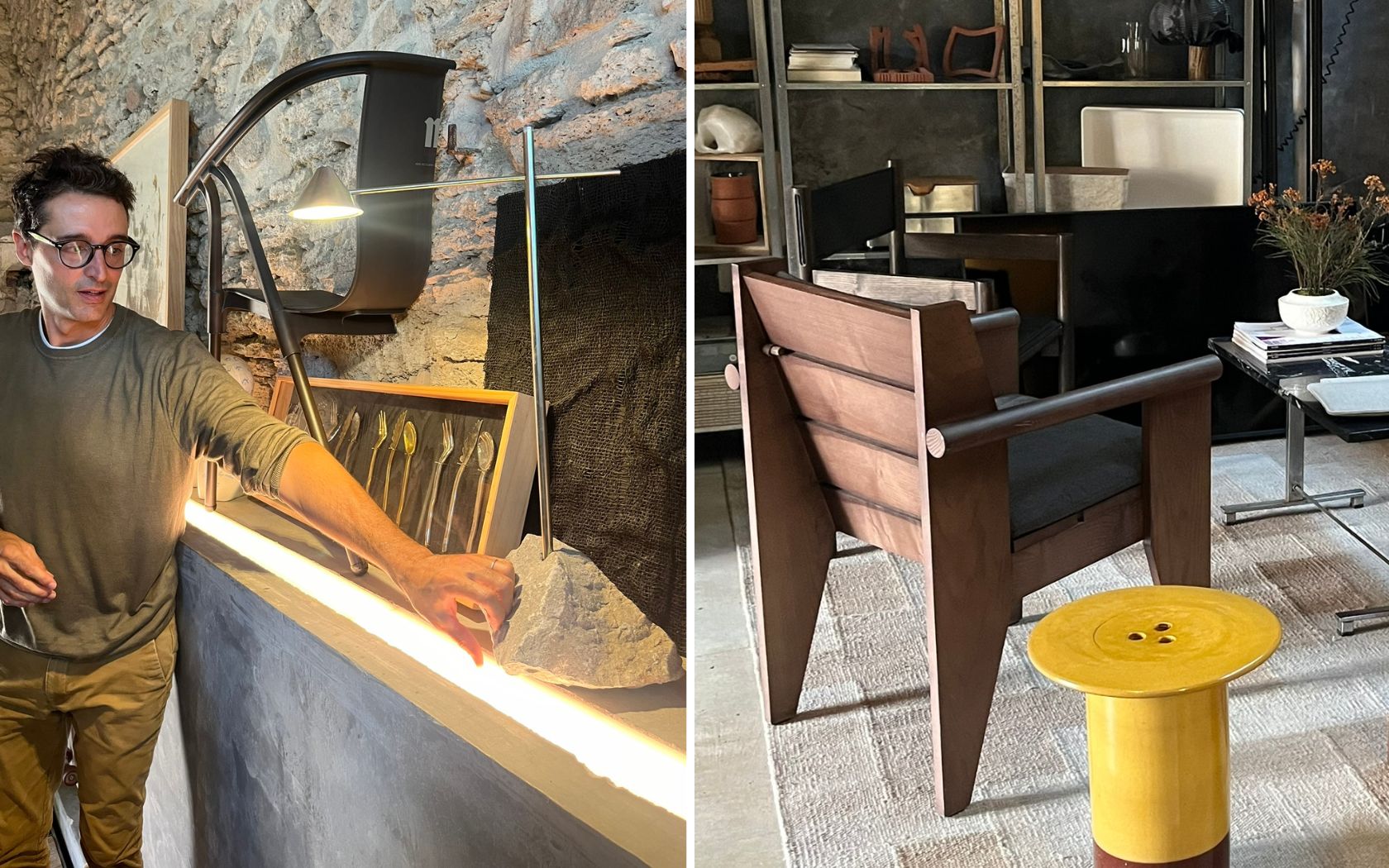Andreu Carulla’s work is an example of how design can be a tool to improve our lives and our world. He founded his studio in 2006 in Girona with projects that include furniture, tableware, lighting, fashion and interior design, always based on sustainability, craftsmanship and the constant exploration of materials.
On the occasion of the photo shoot for the outdoor furniture brand Calma Outdoor, we had an inspiring conversation with industrial designer Andreu Carulla. It was an informal and relaxed meeting in a beautiful farmhouse near Banyoles (Girona) with Pete Sans, author of the iconic ‘Coqueta’ chair, Ricard Vicens, head of Calma Outdoor and Xavi Roca, founder of Run Design. An ideal opportunity to talk about design and be inspired by the environment.

General view of the new Calma Outdoor collection. Photography: Carlota Grau.
The reason for the meeting is the presentation of the new collection ‘Brava’ of Calma Outdoor, whose creative direction is in charge of Andreu Carulla. We chatted with him about the collection and some of his most significant projects.
Timeless, minimalist and sustainable design
Under the artistic direction of Andreu Carulla, the Calma Outdor collection stands out for clean designs without superfluous elements, made with iroko wood, known for its durability. The textiles are of high quality and manufactured less than 70kms from the factory. All chairs are ergonomic and are designed to achieve a comfortable and healthy posture.

Left: Sofa from the Brava collection. Right. Set of tables and chair from the Brava collection and luminaire from the Normal collection. Photography: Carlota Grau.
Since 2019 you are Creative Director of Calma Outdoor, the outdoor furniture brand founded on the Costa Brava. What values do you bring to the brand?
Above all timelessness and a sustainable product in terms of materials used and processes. Also a sensitivity towards the producers we have around us, since the manufacturing is carried out entirely between the provinces of Girona and Barcelona.
How do you define your role in the creative direction of Calma?
It is based on choosing what types of products should be included in the brand’s catalog and what these products have to transmit to us. In a way, it is to transfer the sensibility that we have in the studio into a brand that everyone can enjoy at home, in a restaurant or a hotel.
What is sustainable design for you?
Ideally, it would be to take advantage of an existing design. Sustainable design means improving a process, minimizing the impact of transportation and using local materials.

Left. Daybed. Right. Balinese, both from the Brava collection. Photography: Carlota Grau.
Have you turned down projects that did not have a link to sustainability?
In our career, rather than rejecting projects that have nothing to do with sustainability, we have turned away from brands or potential clients with whom we did not share values.
‘For me, in sustainable design, the ideal would be to take advantage of an existing design’.
The importance of silent design: less noise, more essence in each piece
The design philosophy for Andreu Carulla and his team is based on creating discreet and versatile products that do not impose a particular style. They value the harmony between the personality of a piece and its ability to adapt to different environments.
We believe that a successful design is one that does not compete for attention, but becomes a silent and durable companion.
What is silent design?
It is something we use regularly in the studio, as opposed to the concept of aesthetic noise. A noisy piece is one that wants to be very prominent and is above the rest. We like to seek balance.

Left: table and chairs from the Brava collection. Right: luminaires of different sizes from the Normal family. Photography: Carlota Grau.
The ‘Brava’ collection is a great example of this. It is very minimal in its gestures and we have only allowed ourselves a single aesthetic licence, which is this ribbing that ends in a rounded geometry that we consider to be a little Romanesque. It gives it just the right personality to make it identifiable, to give it character and to provide something else that we believe was lacking in the market.
Industrial design in the digital era
How do you see the future of industrial design?
Industrial design is undergoing a revolution driven by Artificial Intelligence. Tools like ChatGPT have accelerated design processes and opened up new creative possibilities.
Industrial design will become more accessible thanks to technology, but the creative ability and strategic vision of designers will remain key to standing out. Digital tools will simplify technical processes, and the tools that created a technical barrier to becoming an industrial designer will no longer exist, allowing for a greater democratisation of design.
Making a rendering is very easy today, and it will be even easier tomorrow. Modelling a part was complicated 20 years ago, but today it is starting to become easier. What we will be left with is the creative ability or the orientation of where you want to go.
‘Industrial design will become more accessible thanks to technology, but the creative ability and strategic vision of designers will still be key to standing out’.
The future designer should focus on generating original ideas and understanding people’s needs.
What are your latest projects?
We are preparing an exhibition in Japan that we are going to do with a Muji brand for next summer. It’s going to fuse our vision of design with the ancestral design of the Costa Brava and Catalan Mediterranean furniture.
Since we started with the Roca Brothers designing the Normal restaurant in 2021, we have expanded our interior design services, working on projects for clients such as Casa Bonay. We have a heavy workload with Esperit Roca, which includes the restaurant, the hall, the museum, the wine cellar and a gym.

Left. Wireless lamp by Esperit Roca. Right. Yellow Bolet chair / stool by Calma outdoor and chair by Esperit Roca. Editorial credit: Magazine Horse.
The most beautiful thing is that we do interior design work and we design all the pieces to measure, creating unique pieces such as chairs, tables, lamps…
What advice would you give to young people who are studying design?
They need to draw more, put their mobiles and Instagram to one side a bit more and work in any design studio as interns to learn, do and think. Thinking is more important than asking chatGTP.
What cultural influences have shaped your style and approach?
What has shaped me is living outside the city and working in a village. It has given me peace and quiet and plenty of time to work. The good thing is that it hasn’t taken away the more urban side of being able to enjoy the cities. We have clients in Japan, Singapore, Finland… However, I have been greatly influenced by the environment in which I have grown up and where I have developed as a designer.
Is there a designer who has inspired you and been your reference?
I was influenced by working with Rafael Marquina. He and Pete Sans have very disruptive and unconventional points of view. They influenced me a lot in my beginnings.

Studio team from left to right: Albert, Marta, Anna, Fernando, Addaia, Miriam, Andreu.
__
The more personal side…
What role does your family play in your creative process?
My personal and professional life are very intertwined thanks to my family. With Miriam, my wife, we have four children who come to the studio. We involve them in my projects. The family is very important and for me it is a fundamental element in my life and in my stability.
What inspires you outside the world of industrial design?
What helps me a lot is doing sport in my daily life: swimming, running, canoeing… That’s what inspires me the most. I love art and music. Even if I don’t know how to play an instrument, there is always music in the studio.
What is your morning routine?
Monday, Wednesday and Friday I get up at 5.45am and at 8am I’m in the swimming pool or the gym, I come home, prepare breakfast with Miriam for the children and I go to school at 8.50am. At 9am I’m in the studio and before 7pm I try to be home with the family.
A pending trip.
Patagonia, both the Chilean and Argentinean parts. We were supposed to go and had to cancel at the last minute.
A place you would always go back to.
Finland.
A design object you would buy.
Many by Miguel Milá, and now I’m waiting to buy a Poulsen.




